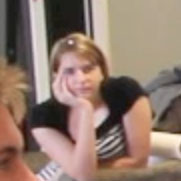Everyone has a natural, relaxed “neutral” face that expresses no particular emotion. It is sometimes described as “blank” (since it expresses nothing in particular) or “slack,” since there is no particular muscle tension used to create a deliberate facial expression.
The eyes are open (with brows neither raised nor lowered), the lips are closed or very slightly open (but not pursed or pressed together), the face muscles are all relaxed.
Here are a couple of examples (taken when each woman was sitting alone, not aware of being observed):
This is hardly ever seen during a face-to-face conversation, when we are all constantly sending social signals, but it may be seen when someone is sleeping (except in that case, the eyes are closed), staring into space, sitting alone, watching TV, etc.
Here are a couple of examples, captured via webcam, taken when the person was looking at something else on the computer screen:
In public, some people may deliberately maintain a neutral face to signal that they want to be left alone (in which case they will not have the relaxed posture that typically goes along with this, but rather a tenser, defensive, “closed” posture, e.g., arms crossed and/or muscles clenched).
Interestingly, people do not usually have neutral faces when they speak on the telephone, even though they know that the person they are speaking to can’t see them; we just can’t help ourselves! We’re so used to using all our systems of social signaling together, in a unified way, that when we put emotion into our voices, we automatically put it into our faces and postures, too.



